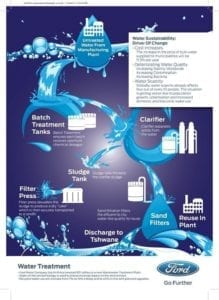According to its 15th annual Sustainability Report, Ford Motor Company is furthering its commitment to aggressively step up water conservation programmes at its global facilities and among the company’s suppliers.
The company believes it is a basic human right to have clean, affordable drinking water and access to sanitation, and last year Ford reduced per vehicle water use by 30 percent globally from a 2009 baseline, reaching its goal two years ahead of schedule. Plans are under way to further cut water use by another 2 percent this year and to set new long-term goals. John Fleming, executive vice president, Global Manufacturing and Labour Affairs for Ford Motor Company says, “As Ford continues with its largest global expansion in more than 50 years, the company also recognises that working in regions struggling with water scarcity will soon make water a costly commodity. From a business perspective, understanding future constraints and immediately reducing Ford’s water consumption makes sense.” Later this year, Ford will begin asking high water-use suppliers and those working in water-stressed regions to voluntarily report water consumption. Ford will then work with the suppliers to achieve reductions. The hope is that successful initiatives will be mirrored by other suppliers globally, helping Ford to significantly reduce its environmental footprint. Across the globe, examples of Ford’s success with water conservation are numerous.In Africa, Ford Motor Company of South Africa (FMCSA) understands that the long-term future of its business in the country requires a commitment to the environment. FMCSA has already invested R21 million in a new Wastewater Treatment Plant (WWTP), which boasts the latest technology to facilitate the manufacturing of the Ranger at its Silverton Assembly Plant.
The plant’s capacity to process water has increased from 60 percent to 100 percent, while 20 percent of that water is then used in industrial processes at the facility. The old effluent plant was not able to handle the peak volumes, the new WWTP can now handle 100% of the maximum volume of waste water the plant produces. Ford began strategically working to improve the company’s water impact globally in 2000 by setting year-over-year reduction targets as part of its Global Water Management Initiative. The success of the initiative is measurable. Not only has the company reached its water-use-per-vehicle goal two years ahead of schedule, it cut global water use by 61 percent, or by more than 37 million litres, between 2000 and 2013. That savings is the equivalent of 1 billion five-minute-long showers, according to the U.S. Environmental Protection Agency. The total amount of water used around the globe at Ford facilities went from 64 million cubic metres per year to 25 million cubic meters.







